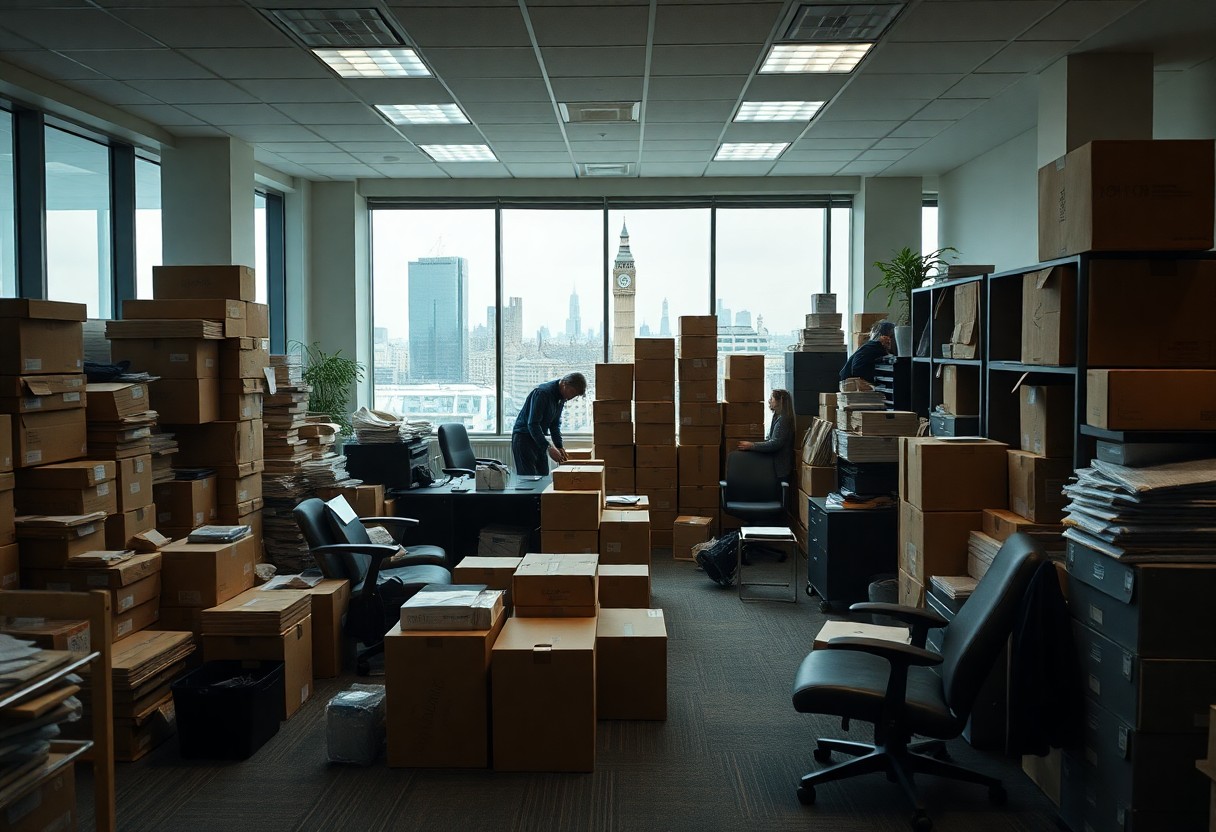Over the course of your office clearance in London, you will encounter various tasks that can be both daunting and rewarding. To ensure a smooth process, you must plan meticulously and stay organised. From sorting through documents to disposing of unwanted furniture, your approach will determine not just the efficiency of the clearance, but also the impact on your workspace. This guide provides crucial steps to manage your office clearance effectively, turning what can often be a stressful experience into a positive transition.
Understanding the Office Clearance Process
Before you initiate the office clearance, it is imperative to grasp the entire process involved. This typically includes planning, assessing what needs to be removed, organising logistics for the clearance day, and ensuring that all items are disposed of responsibly. Engaging with a professional clearance service can simplify this journey and provide valuable guidance, making your office clearance in London a seamless experience.
How to Assess Your Office Clearance Needs
Clearance begins with evaluating your office space and identifying items that need removal. Consider factors such as the condition of your furniture, outdated equipment, and any confidential materials that require secure disposal. By having a clear understanding of what you no longer need, you can streamline the entire clearance process.
Tips for Creating an Inventory of Items
Inventory your office items to make the clearance process more efficient. Consider the following tips:
- List all items, categorising them into furniture, equipment, and documents.
- Include the condition of each item for informed decisions.
- Mark items that require sensitive disposal.
- Identify any items that can be donated or recycled.
After compiling this list, you’ll have a better grasp of what needs to be addressed during the clearance.
With a comprehensive inventory, you can efficiently manage your office clearance. You should ensure to document every item accurately and update your lists as you go. Additionally, emphasise important details such as:
- Allocate a timeframe for each category of items.
- Involve your team members for input and assistance.
- Utilise a digital tool for organisation and easy access to your inventory.
After finalising your inventory, you’ll be well prepared for a smooth office clearance process.

Factors to Consider Before the Clearance
Assuming you are planning an office clearance in London, there are several factors you should take into account:
- Size of the office
- Nature of the items
- Value of assets
- Timeframe for clearance
- Budget constraints
This will help ensure the process runs smoothly and efficiently.
Compliance with Local Regulations
Now, it is important to be aware of and comply with local regulations that may impact your office clearance. This includes understanding the relevant laws regarding waste disposal and recycling to avoid any potential fines or legal issues.
Environmental and Sustainability Considerations
To promote sustainability, you should carefully consider the environmental impact of your office clearance. You can opt for services that focus on recycling and responsibly disposing of office materials instead of sending everything to landfill.
Compliance with environmental guidelines not only contributes to a healthier planet but also enhances your company’s image as a socially responsible entity. Engaging in recycling initiatives helps divert waste from landfills while ensuring any hazardous materials are disposed of in a safe manner. You should also consider donating unsalvageable items in good condition to local charities, which promotes a positive community relationship. Ultimately, adopting sustainable practices during your office clearance can lead to a more cost-effective and environmentally friendly process.
How to Choose the Right Clearance Company
Some considerations are necessary when selecting the right clearance company for your office. You should look for a provider that understands your specific needs. A reputable option is one that can guide you through an Office Moving Checklist tailored for your situation, ensuring that no detail is overlooked.
Researching and Comparing Services
| Factor | Consideration |
|---|---|
| Experience | Years in the industry and successful projects |
| Cost | Transparent pricing and no hidden fees |
| Reviews | Client testimonials and ratings |
| Services Offered | Comprehensive solutions beyond just clearance |
Questions to Ask Potential Providers
Potential providers should be thoroughly vetted to ensure they align with your requirements. Prepare a list of questions that can help you gauge their reliability and services. Inquire about their licensing, insurance coverage, and whether they follow proper disposal regulations. Ask them how they handle sensitive materials and whether they offer recycling options. This will give you insight into their professionalism and commitment to responsible practice.
A detailed conversation with potential providers can uncover vital information. Ask about their experience in office clearance specifically, and whether they have worked with businesses similar to yours. Discuss their approach to scheduling and any potential disruptions to your daily operations. Ensuring that they have a robust plan in place will assure you that your clearance process will run smoothly and efficiently.
Preparing Your Office for Clearance
To ensure a smooth office clearance, you need to prepare your workspace effectively. Consider creating a timeline for the clearance process, allowing sufficient time to organise and sort through your items. Make a checklist of the various areas and aspects of your office that require attention, from furniture to paperwork, to ensure nothing gets overlooked.
Organising and Sorting Items
Preparing for the clearance involves sorting and categorising your items. Start by dividing your belongings into distinct groups such as keep, donate, recycle, and discard. This will help streamline the clearance process, making it more efficient and manageable. Ensure you involve your team to gather input and facilitate decision-making.
Tips for Minimising Downtime
If you are worried about how an office clearance might disrupt productivity, focus on strategies to minimise downtime. Implement these tips to maintain efficiency during the transition:
- Plan the clearance during off-peak hours.
- Communicate with your staff about clearance dates.
- Set up a temporary workspace for vital tasks.
Thou should ensure that all team members are informed and prepared before the clearance begins to minimise interruptions.
Downtime can significantly affect your business operations, so effective planning is vital. Consider holding meetings before the clearance to discuss roles and responsibilities, aiming to maintain workflow and morale. Here are some more tips to help you minimise the impact:
- Utilise a professional clearance service for efficiency.
- Set clear priorities for task delegation.
- Offer incentives for staff to maintain productivity during the clearance.
Thou must ensure that all preparations are made in advance to support a seamless transition in your office environment.
What to Expect During the Clearance Process
Once again, the office clearance process can vary depending on the size of your workspace and the volume of items being removed. You can expect a team of professionals to arrive, assess the area, and discuss any specific requirements you have. They will efficiently sort through items, identifying what can be recycled, donated, or disposed of. The process generally involves careful handling to ensure your remaining assets are left undisturbed and the space is left clean and tidy.
Timeline and Logistics
For an efficient office clearance, a well-planned timeline is vital. You should work with the clearance team to establish a suitable date and time for the operation. Discussing logistics in advance helps avoid any delays and allows you to coordinate with your team, ensuring everyone is informed and prepared for the clearance activities ahead.
Ensuring a Smooth Operation
One way to ensure a smooth operation during your office clearance is by communicating your expectations with the clearance team. You should provide a clear plan of areas to focus on and any items that require special handling. This allows the team to tailor their approach according to your needs and guarantees that the clearance runs efficiently.
Another effective method is to have all your employees informed about the clearance dates and processes. Encourage them to declutter their personal items beforehand, making it easier for the clearance team to access workstations. Additionally, having a designated contact person during the operation can streamline communication, allowing quick resolutions to any questions or issues that may arise. Ultimately, effective planning and communication will foster a positive clearance experience.

Post-Clearance Considerations
After completing your office clearance in London, it’s vital to reflect on the process and evaluate how effectively your objectives were met. For advice on moving forward and planning for the future, check out How to plan a London Office Clearance.
Evaluating the Clearance Outcome
If you assess the results of your office clearance, consider your initial goals and whether they were achieved. Take stock of which items were successfully removed, and evaluate the condition of your new workspace. This can help you identify any further actions required to optimise your office environment.
Tips for Setting Up Your New Environment
There’s a lot to consider when establishing your new office setup. Focus on ergonomics, organisation, and functionality to create an inviting and productive workspace. Involve your team in the design process to ensure a sense of ownership, and don’t shy away from incorporating technology that enhances collaboration. The
workspace should reflect your company’s culture and ethos. Here are some aspects to focus on:
- Comfortable furniture for long hours of working
- Effective storage solutions to keep your office clutter-free
- Collaborative areas for team discussions and creativity
To make the most out of your new office environment, consider these key aspects:
- Natural lighting to enhance overall well-being
- Personal touches to make your space feel inviting
- Clear layout for ease of movement and accessibility
The goal is to create a space where you and your colleagues can thrive, promoting productivity and morale.
Conclusion
Taking this into account, preparing for an office clearance in London involves thorough planning and organisation. You should begin by assessing your current office assets, deciding what to keep, sell, or dispose of. Communicate effectively with your team to ensure everyone is on the same page, and schedule the clearance well in advance to avoid disruptions. Engaging a professional clearance service can help streamline the process, allowing you to focus on your core business activities while ensuring a smooth transition. Your careful preparation can lead to a successful office clearance and a fresh start in your new workspace.
FAQ
Q: What are the initial steps to prepare for an office clearance in London?
A: The first step is to assess the items that need to be cleared. This involves conducting a thorough inventory of furniture, equipment, and other belongings. Once you have a clear idea of what needs to be removed, you should categorise them based on priority, condition, and whether they will be reused, recycled, or disposed of. It is also wise to consult with staff members to ensure that all necessary items are accounted for and that there is transparency throughout the process.
Q: How can I efficiently organise the office clearance process?
A: Efficient organisation begins with setting a clear timeline for the clearance. Allocate specific dates for different phases, such as sorting, removal, and cleaning. Assign roles to team members, if necessary, to help in the sorting process. Providing clear guidelines on how to handle different types of items, such as confidential materials or electronic waste, can streamline the process. Additionally, engaging a professional clearance service in London can save time and ensure adherence to regulations.
Q: What should I do with confidential documents during the office clearance?
A: Confidential documents must be handled with care to protect sensitive information. It is advisable to shred or securely dispose of any papers that are no longer needed. If you prefer to retain important documents, consider creating a digital backup or using a secure storage solution. Hiring a professional clearance service that offers shredding services can also ensure these materials are disposed of in compliance with data protection regulations.
Q: Are there specific regulations I need to be aware of during an office clearance?
A: Yes, compliance with environmental regulations is crucial during an office clearance in London. This includes understanding waste disposal laws and ensuring that items such as electronics and hazardous materials are discarded properly. You may also need to consider compliance with data protection legislation when dealing with confidential materials. Consulting with a professional removal company can provide guidance on adhering to these regulations.
Q: How can I minimise the environmental impact of my office clearance?
A: Minimising environmental impact involves several strategies. Begin by donating unwanted furniture and supplies to local charities or businesses rather than sending them to landfill. Ensure that recyclable materials are separated to facilitate proper recycling processes. When hiring a clearance service, choose one that prioritises environmental responsibility and has a robust recycling programme. Additionally, consider reducing the volume of items cleared by adopting a more minimalist approach to office supplies and furniture.


